View in other NatureServe Network Field Guides
NatureServe
Montana
Utah
Wyoming
Idaho
Wisconsin
British Columbia
South Carolina
Yukon
California
New York
Tall Buttercup - Ranunculus acris
State Rank Reason (see State Rank above)
Ranunculus acris is a plant native to central and northeastern Europe and introduced into North America (Jacobs et al. 2015). A conservation status rank is not applicable (SNA) because the plant is an exotic (non-native) in Montana that is not a suitable target for conservation activities.
General Description
PLANTS: Perennial forbs with hirsute (straight, stiff hairs) foliage and erect stems 25–80 cm tall. Plants are rhizomatous. Source: Lesica et al. 2012
LEAVES: 40-50 basal leaves have long petioles, up to 20 cm, that each terminate into a single leaf blade. Basal leaf blades are 3-6 cm long and pentagonal (5-sided) in shape that are mostly deeply divided into about 3 palmate lobes that again deeply divided into 2-3 acute segments. Stem leaves resemble basal leaves, but alternately arranged and become smaller and sessile upwards. The upper stem leaves become reduced to 3- to 5-lobed bracts. Source: FNA 1997; Lesica et al. 2012; Jacobs et al. 2015.
INFLORESCENCE: Yellow flowers are arranged in diffuse, open cymes. The 5 sepals are symmetrical, greenish, bend downwards, and have soft, spreading hairs. The 5 petals are symmetrical, 8–10 mm long (twice as long as the sepals), buttercup yellow, and shiny. Source: FNA 1997; Lesica et al. 2012; Jacobs et al. 2015.
The genus Ranunculus comes from the latin words rana for frog and unculus for little, and is in allusion to the wet habitats in which some species grow (FNA 1997).
Phenology
May through September (FNA 1997).
Diagnostic Characteristics
Ranunculus and
Potentilla can be look-alikes because some species exhibit symmetrical flowers composed of 5 green sepals and 5 bright yellow petals that surround many ovate achenes (fruits).
Ranunculus species are in Family Ranunculaceae. Flowers exhibit shiny yellow petals, sepals that are separated to their base, and lack bracts between the sepals. In generalizing and looking from a distance, plants don’t appear hairy and seem rather darker green and glossier. Achenes are beaked.
Potentilla species are in the Family Rosaceae. Yellow-flowered forbs tend to have matted yellow petals, sepals united at their base and at least partially united to the ovary (forming a hypanthium), and often have bracts between the sepals. In generalizing and looking from a distance, plants often appear hairy and lighter or dull green. Achenes are not beaked.
Tall Buttercup -
Ranunculus acris, exotic and Noxious:
* Basal leaf blades pentagonal (5-sided) in shape that are mostly deeply divided into about 3 palmate lobes that again deeply divided into 2-3 acute segments. Ultimate leaf segments are more numerous.
* Beak of the achene is about 0.5 mm long.
* Sepals spread outwards.
* Collectively the fruits are globose in side-view.
Sharpleaf Buttercup -
Ranunculus acriformis, native and desirable:
* Basal leaf blades are broadly ovate to cordate in outline, deeply 3-divided (ternate). Sepals reflexed. Ultimate leaf segments are less numerous.
* Beak of the achene is about 1mm long and more compressed.
* Collectively the fruits are hemispheric in side-view.
Species Range
Montana Range
Range Descriptions
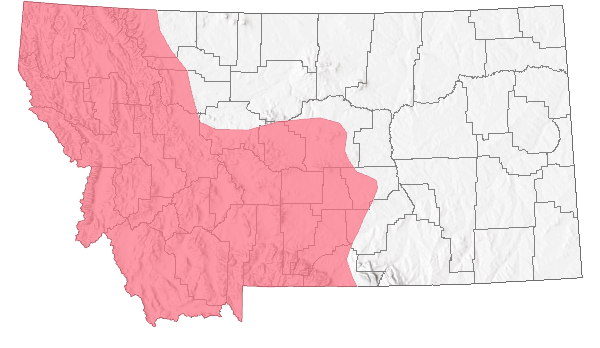
 Non-native
Non-native
Range Comments
Tall Buttercup is native to central and northeastern Europe (Jacobs et al. 2015). Introduced AK to NL and south to CA, AZ, TN, GA; South America, Eurasia, and Australia (Lesica et al. 2012).
In Montana Tall Buttercup was first documented near Bozeman, Gallatin County in 1916.
For maps and other distributional information on non-native species see:
Nonindigenous Aquatic Species Database from the U.S. Geological Survey
Invasive Species Habitat Tool (INHABIT) from the U.S. Geological Survey
Invasive Species Compendium from the Centre for Agriculture and Bioscience International (CABI)
EDDMapS Species Information EDDMapS Species Information
Observations in Montana Natural Heritage Program Database
Number of Observations: 1301
(Click on the following maps and charts to see full sized version)
Map Help and Descriptions
Relative Density
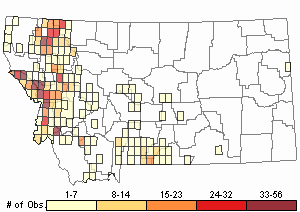
Recency
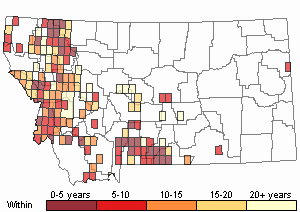

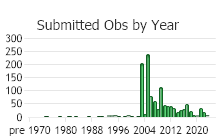
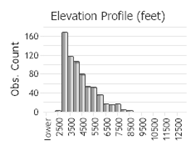 (Observations spanning multiple months or years are excluded from time charts)
(Observations spanning multiple months or years are excluded from time charts)
Habitat
In its native range, Tall Buttercup is common in damp meadows and pastures on calcareous or neutral soils (Jacobs et al. 2015). On the British Isles is grows on rock ledges, gullies, and occasionally on mountain top detritus (Jacobs et al. 2015). In the Netherlands is grows in floodplains along rivers, preferring areas with about 30 days of flooding per year (Jacobs et al. 2015).
In Montana, Tall Buttercup predominately grows in moist meadows and pastures, especially irrigated hay fields (Lesica et al. 2012; Jacobs et al. 2015). It is less abundant in wildland habitats (Lesica et al. 2012). It also grows along roads, along ditches and natural waterways, and in borrow pits and parking lots (Jacobs et al. 2015). It occurs in valleys and occasionally at higher elevations (Lesica et al. 2012).
Ecology
In a given flower stamens produce pollen after the stigma of that flower is receptive; therefore, cross pollination is necessary for seed production (Jacobs et al. 2015). If pollinators are scarce then seed production is reduced.
Potential and Known Pollinators:
The following animal species have been reported as pollinators of this plant species or its genus where their geographic ranges overlap:
Bombus auricomus,
Bombus bifarius,
Bombus nevadensis, and
Bombus bimaculatus (Macior 1968, Thorp et al. 1983).
Tall Buttercup grows and reproduces poorly when under competition from other plants (Jacobs et al. 2015). Disturbances that remove competitive vegetation increases the survival rate of Tall Buttercup seedlings. Tall Buttercup growing at sites with few species (low competition) or high soil fertility will tend to produce more flowers. In plant communities with high species diversity, regeneration by Tall Buttercup rhizomes is reduced. However, plants will increase rhizome reproduction within its colony of clones [see Rhizomes under Reproductive Characteristics]. Seedlings growing in either well-drained soils or water-logged soils have reduced survival rates.
Tall Buttercup have aerenchyma cells in their rhizomes that store air and allow plants to tolerate low-oxygen conditions created by flooding (Jacobs et al. 2015).
Reproductive Characteristics
Tall Buttercup reproduces from seeds and rhizomes. Tall Buttercup generally has low fecundity, often producing less than four flowers per plant. Decayed leaf petioles produce wiry, persistent fibers (plants root at their nodes.)
FRUITS
Collectively the fruits (achenes) create a head that is 6-9 mm tall. Each fruit (achene) is glabrous and 2–3 mm long with a curved beak of 0.5 mm long.
RHIZOMES
Tall Buttercup plants develop a stout, abruptly ending rootstock. The rhizomes are short and thick, and on their underside grow thick roots. The rhizomes grow when flowering stems are not developing, after flowering, or when removed from cutting, defoliation, disease, livestock trampling, or other disturbances. Without flowering stems the apical dominance is released which allows the lateral buds on the rhizomes to grow. Rhizomes grow to form new rhizomes which later separate from the parent plant. These clones (or daughter plants) can form clumps about 1 meter (3 feet) in diameter. New shoots re-impose apical dominance over the remaining lateral buds on the rhizome. Thus, there are always a continuous supply of buds on the rhizomes that are capable of regeneration.
LIFE CYCLE
Tall Buttercup plants have been reported to live from 4 years (in the grasslands of Wales) to 14 years in Russia. In late winter to early spring rhizomes split, elongate, and at their apical buds will grow plants that 40-50 new basal leaves. Plants undergo a leafy stage, whereby leaves form and growth of the flowering stem is delayed. After this, leaf production declines. Less than 1% of plants produced by the rhizome survive.
In late summer flower buds develop, but will not flower until the next summer. Plants can also remain vegetative and not flower until 3-10 years later. Low winter temperatures will promote flower development while high population densities reduced flowering. In cultivation plants may flower in the same year that flower buds develop. The ability to flower and set seed does not decline with age, at least up to 10 years of age. High soil moisture will extend the length of flowering. In Norway, flowering occurred into early fall while in New Zealand flowering occurred all year. At flowering time basal leaves begin to die. Flowering stems die after flowering.
Seeds mature by late summer into fall. Seeds buried in the top 2.5 centimeters of soil often survive for less than two years. Seeds buried from 3-4 centimeters can survive for 10-16 years, even after Tall Buttercup disappears from the plant community. Seed bank densities have been reported from 3 seeds per square yard in Quebec, Canada to 300 seeds per square yard in England, to 2,600 seeds per square yard in New Zealand. Although Tall Buttercup seeds often germinate in the first year, less than 1% of the seedlings will survive.
Each achene is tipped by a short-hooked beak and contains a single seed. The hooked beak of the achene can attach to animal fur and human clothing which can disperse seeds long distances (Jacobs et al. 2015). Seeds that fall into moist soil can be picked up and transported by the shoes of humans and hooves of grazing animals. Tall Buttercup seeds fed to cows were viable after passing through their digestive tract, and another study estimated that cows could disperse 9,400 seed during a 165-day grazing season. Seeds can also be dispersed through contaminated hay, water currents, vehicles, farm equipment, and other means.
Management
Tall Buttercup is predominately a weed problem in hay meadows and pastures. Successful management of Tall Buttercup requires that land-use objectives and a desired plant community be identified (Sheley and Petroff 1999). Once identified then an integrated weed management strategy that promotes a weed-resistant plant community and serves other land-use objectives such as livestock forage, wildlife habitat, or recreation can be developed, making control of Tall Buttercup possible (Sheley and Petroff 1999).
PREVENTION* Prevent vehicles from driving through and animals from grazing within infested areas,
* Thoroughly wash the undercarriage of vehicles and wheels in a designated area before moving to an uninfested area,
* Encourage landowners to monitor their land for new infestations and, when found to implement effective control methods.
* Maintain proper livestock grazing management that maintains desirable, competitive vegetation.
* Develop educational campaigns to teach people to not pick and transport the buttercup flowers.
PHYSICAL and CULTURAL CONTROLS [Adapted from Jacobs et al. 2015]
Hand-pulling that extracts all the rootstock can be effective to temporarily reduce small infestations and scattered plants. It works best to eliminate new plants or those persisting after herbicide treatments. Rhizomes that remain in the soil will regenerate and follow-up hand-pulling or other controls will be needed. Pull new plants from rhizomes or the seed bank will reduce seed production.
Mowing can aid in reducing flowering/seed production if timed correctly with a frequency that promotes desirable plants to grow. Plants that are mowed will re-grow. Mowing that maintains an open site with little plant diversity will encourage Tall Buttercup to flourish.
Tilling is not recommended unless it is combined with an Integrated Weed Management plan. The disturbance caused by tilling allows rhizomes to re-sprout, seeds to germinate, and reduces plant competition, all of which favors colonization by Tall Buttercup.
Irrigation can promote Tall Buttercup because it prefers moist conditions and can tolerate flooding. However, an Integrated Weed Management plan that carefully manages irrigation with other control practices can be effective at reducing or eliminating Tall Buttercup. In irrigated and sub-irrigated pastures and hayland, properly timed irrigation can increase competitiveness from appropriate forage crops when also timed appropriately with fertilization and grazing and/or harvest practices.
Nutrient management with a judicious use of herbicides and crop rotation is recommended where Tall Buttercup invades non-native pastures and hay meadows. Applications of nitrogen, phosphorus, and potassium may reduce the abundance of Tall Buttercup where the growth of grasses can over-top and shade it. However, in disturbed settings fertilizers may have little effect on Tall Buttercup perhaps because high-light and/or low competition remains.
Prescribed burning is not commonly used in the moist habitats were Tall Buttercup grows. Fire can re-generate rhizomes and germinate seeds. However, fire is often used to retain vigor and density in grasslands because it reduces plant litter and releases nitrogen. Fire used in combination with other control methods might be appropriate to reduce Tall Buttercup populations.
GRAZING CONTROLS [Adapted from Jacobs et al. 2015]
Tall Buttercup contains glycoside ranunculin which if ingested by livestock can potentially be fatal. Livestock typically avoid Tall Buttercup. The palability of Tall Buttercup to sheep or goats is unknown.
Several studies from Finland, Iceland, and Great Britain suggest that Tall Buttercup increases with grazing. In these studies, litter removal, exposure of bare ground, and suppression of competitive grasses were thought to facilitate the increase of Tall Buttercup. However, a prescribed grazing management plan that uses livestock to promote the competitiveness of desirable forage plants will prevent Tall Buttercup invasion or re-invasion after weed control. In sites with Tall Buttercup spring grazing is not recommended because it will likely remove desirable plants, limiting their growth and ability to shade it out. In addition, Tall Buttercup exhibits its most leafy stage in the spring.
CHEMICAL CONTROLS [Adapted from Jacobs et al. 2015]
The herbicide type and concentration, application time and method, environmental constraints, land use practices, local regulations, and other factors will determine its effectiveness and impact to non-target species. Strict adherence to application requirements defined on the herbicide label will reduce risks to human and environmental health. Consult your County Extension Agent and/or Weed District for information on herbicidal control. Consult your County Extension Agent and/or Weed District for more information on herbicidal control. Chemical information is also available at
Greenbook.
Aminopyralid and
dicamba herbicides have been used to control Tall Buttercup. The leafy phase prior to flowering stem development (late spring) is the optimal time to apply herbicides.
In New Zealand plants have become resistant to the
phenoxy herbicide MPCA. To avoid the development of herbicidal resistant populations, integrate herbicidal control with other practices and use herbicides with different modes of action.
BIOLOGICAL CONTROLS [Adapted from Jacobs et al. 2015]
Currently no biological control agents are available.
Montana's Tall Buttercup Task Force is led by Margie Edsall who can be contacted at: (406) 842-5595 or
medsall@madisoncountymt.govUseful Links:Central and Eastern Montana Invasive Species TeamMontana Invasive Species websiteMontana Biological Weed Control Coordination ProjectMontana Department of Agriculture - Noxious WeedsMontana Weed Control AssociationMontana Weed Control Association Contacts WebpageMontana Fish, Wildlife, and Parks - Noxious WeedsMontana State University Integrated Pest Management ExtensionWeed Publications at Montana State University Extension - MontGuidesStewardship Responsibility
Threats or Limiting Factors
Tall Buttercup contains glycoside ranunculin which upon ingestion can cause blistering of lips and tongue, intestinal disorders, and ventricular fibrillation and respiratory failure, and can be fatal (Jacobs et al. 2015).
Dairy cows that feed on Tall Buttercup can produce bitter tasting milk, and from it bitter butter.
Tall Buttercup plants develop clones which become dense and crowd out native and non-native pasture plants, thereby, reducing forage capacity and plant diversity.
References
- Literature Cited AboveLegend:
 View Online Publication
View Online Publication Flora of North America Editorial Committee. 1997. Flora of North America North of Mexico. Volume 3. Magnoliophyta: Magnoliidae and Hamamelidae. Oxford University Press, Inc., New York, NY. xxiii + 590 pp.
Flora of North America Editorial Committee. 1997. Flora of North America North of Mexico. Volume 3. Magnoliophyta: Magnoliidae and Hamamelidae. Oxford University Press, Inc., New York, NY. xxiii + 590 pp. Jacobs, Jim, Melissa Graves, and Jane Mangold. 2015. Ecology and Management of Tall Buttercup (Ranunculus acris L.). August. U.S. Department of Agriculture, Natural Resources and Conservation Service, Bozeman, Montana.
Jacobs, Jim, Melissa Graves, and Jane Mangold. 2015. Ecology and Management of Tall Buttercup (Ranunculus acris L.). August. U.S. Department of Agriculture, Natural Resources and Conservation Service, Bozeman, Montana. Lesica, P., M.T. Lavin, and P.F. Stickney. 2012. Manual of Montana Vascular Plants. Fort Worth, TX: BRIT Press. viii + 771 p.
Lesica, P., M.T. Lavin, and P.F. Stickney. 2012. Manual of Montana Vascular Plants. Fort Worth, TX: BRIT Press. viii + 771 p. McGregor, R.L. (coordinator), T.M. Barkley, R.E. Brooks, and E.K. Schofield (eds). 1986. Flora of the Great Plains: Great Plains Flora Association. Lawrence, KS: Univ. Press Kansas. 1392 pp.
McGregor, R.L. (coordinator), T.M. Barkley, R.E. Brooks, and E.K. Schofield (eds). 1986. Flora of the Great Plains: Great Plains Flora Association. Lawrence, KS: Univ. Press Kansas. 1392 pp. Sheley, Roger, and Janet Petroff. 1999. Biology and Management of Noxious Rangeland Weeds. Oregon State University Press, Corvallis, Oregon.
Sheley, Roger, and Janet Petroff. 1999. Biology and Management of Noxious Rangeland Weeds. Oregon State University Press, Corvallis, Oregon.
- Additional ReferencesLegend:
 View Online Publication
View Online Publication
Do you know of a citation we're missing? Cope, M.G. 1992. Distribution, habitat selection and survival of transplanted Columbian Sharp-tailed Grouse (Tympanuchus phasianellus columbianus) in the Tobacco Valley, Montana. M.Sc. Thesis. Bozeman, Montana: Montana State University. 60 p.
Cope, M.G. 1992. Distribution, habitat selection and survival of transplanted Columbian Sharp-tailed Grouse (Tympanuchus phasianellus columbianus) in the Tobacco Valley, Montana. M.Sc. Thesis. Bozeman, Montana: Montana State University. 60 p. King, C. R. 1953. The Ranunculaceae of Montana. M.S. Thesis, Bozeman, MT: Montana State College. 82 p.
King, C. R. 1953. The Ranunculaceae of Montana. M.S. Thesis, Bozeman, MT: Montana State College. 82 p. Lesica, P., M.T. Lavin, and P.F. Stickney. 2022. Manual of Montana Vascular Plants, Second Edition. Fort Worth, TX: BRIT Press. viii + 779 p.
Lesica, P., M.T. Lavin, and P.F. Stickney. 2022. Manual of Montana Vascular Plants, Second Edition. Fort Worth, TX: BRIT Press. viii + 779 p. Martinka, R.R. 1970. Structural characteristics and ecological relationships of male blue grouse (Dendragapus obscurus (Say)) territories in southwestern Montana. Ph.D Dissertation. Bozeman, MT: Montana State University. 73 p.
Martinka, R.R. 1970. Structural characteristics and ecological relationships of male blue grouse (Dendragapus obscurus (Say)) territories in southwestern Montana. Ph.D Dissertation. Bozeman, MT: Montana State University. 73 p. Tuinstra, K. E. 1967. Vegetation of the floodplains and first terraces of Rock Creek near Red Lodge, Montana. Ph.D dissertation. Montana State University, Bozeman 110 pp.
Tuinstra, K. E. 1967. Vegetation of the floodplains and first terraces of Rock Creek near Red Lodge, Montana. Ph.D dissertation. Montana State University, Bozeman 110 pp.
- Web Search Engines for Articles on "Tall Buttercup"





